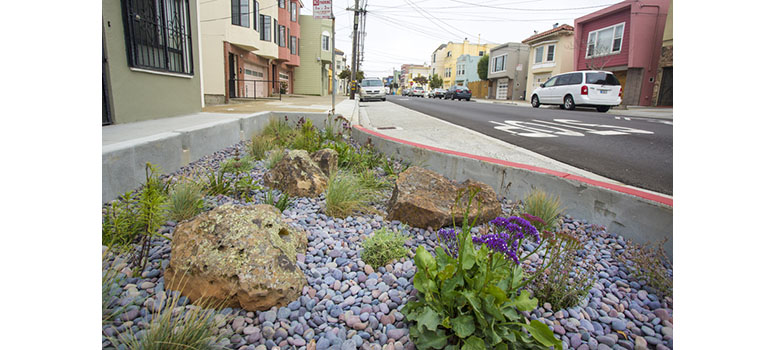The United States Environmental Protection Agency (EPA) last month recognized San Francisco Public Utilities Commission's (SFPUC) Holloway Green Street Project as one of 30 clean-water infrastructure projects putting public money to good use.

Planted bulb-outs and rain gardens constructed on a nine-block stretch of San Francisco’s Holloway Street now provide a way of keeping stormwater out of the sewer system by capturing it upstream. Photo courtesy of SFWater.org
BY BILL PICTURE
Published: December, 2018
The United States Environmental Protection Agency (EPA) last month recognized San Francisco Public Utilities Commission’s (SFPUC) Holloway Green Street Project as one of 30 clean-water infrastructure projects putting public money to good use. EPA’s PISCES program celebrates successful projects from the Clean Water State Revolving Fund (CWSRF) program, a federal-state partnership that provides low-cost financing to communities for water-quality infrastructure upgrades.
For the Holloway Green Street Project, which received an honorable mention, SFPUC applied multifunctional green infrastructure technologies to transform a busy nine-block stretch of Holloway Avenue between Lee and Ashton Avenues into a vibrant pedestrian- and bike-friendly green connector between San Francisco State University and the Balboa Park BART station.
For years, wall-to-wall concrete left stormwater with nowhere to go but into gutters. The Urbano neighborhood just downstream bore the brunt of the “pave it over” urban planning approach of decades past, experiencing flooding when heavy rains would overtax the City’s combined sewer system. Further downstream, wastewater treatment plants unable to handle the deluge during storms would discharge overflow that had been only partially treated into the Pacific Ocean.
“It wasn’t good,” said SFPUC Watershed Planner Sarah Bloom. But keeping stormwater out of the sewer system by capturing it upstream was just part of the project, said Bloom.
“There are lots of different types of green infrastructure and each has its benefits, so the goal is always to find the mix that’s right for a particular site and its conditions, a mix that checks all the boxes so to speak,” Bloom said.
In this case, the project’s goals also included giving residents of a disadvantaged neighborhood, as well as those just passing through, something nice to look at. “Why not make it prettier if you have the chance,” Blooms asked. “During the public input process, residents said they wanted to slow traffic through the neighborhood to make it safer for pedestrians and bicyclists. So that was it! We’d found our sweet spot—storm water management, neighborhood beautification, traffic calming, and pedestrian and bike safety.”
To that end, the final mix includes planted bulb-outs and rain gardens, and permeable pavement in parking lanes. These elements not only help lessen the impact of storms on the sewer system by absorbing rain water, they also drastically change the neighborhood’s look and feel by creating new green spaces to enjoy, and make the neighborhood safer for pedestrians and cyclists.
Heading in the right direction
Bloom is anxious to see how the project performs this winter. It’ll be the first wet season that Holloway Green Street Project has experienced since the plants fully grew in. “We’ll be monitoring it closely for the next two years so we have sufficient data to prove its performance,” she said.
SFPUC expects the Holloway Green Street Project to perform well, and has already set its sights on blocks in the Seacliff neighborhood, which is part of the Richmond watershed.
In terms of the impact this project has had on persons living and working nearby, Bloom says those effects were evident almost immediately. “We’ve had people stop us on the street and ask us to do their block, so I think everyone’s really happy with how it turned out,” Bloom said.
The folks at San Francisco City Hall are also happy because the 18-month-long project came in under budget. “Crazy, right? That almost never happens,” Bloom said.
The project’s total price tag was $7.4 million. SFPUC cracked opened its wallet to cover the cost of the design and planning, which came to $1.6 million. The remaining $5.8 million was paid for with money from the CWSRF. Established by Congress as part of the Clean Water Act of 1987, CWSRF has since provided more than $132 billion in funding for water-quality infrastructure projects.
Bloom said coming in under budget is a particularly impressive accomplishment given that some of the elements, like the permeable pavement, had never before been employed in a project that involved a public right-of-way.
“So there was a bit of a learning curve involved,” she said. “Our contractor, M Squared, took that ride with us; a lot of the credit goes to them.”
“The scale and complexity of the 2018 PISCES recognized projects represent the determination, coordination and creativity our partners put forth to achieve their water quality goals,” EPA Office of Water Assistant Administrator Dave Ross said in a written statement.
While the Holloway Green Street Project wasn’t among the five projects to be touted as “exceptional” by the EPA, Bloom said being recognized at all is a huge honor. It’s important to note that the Holloway Green Street Project was the only project in the state to be acknowledged by the EPA.
“That’s a big deal,” Bloom said. “It means we’re on the right track. Again, we only recently started employing green infrastructure in the public right-of-way, so this definitely tells me we’re heading in the right direction.”

